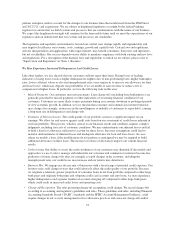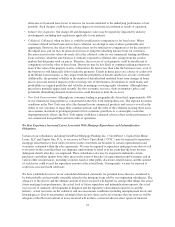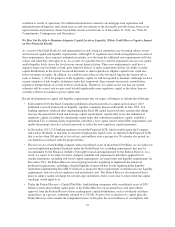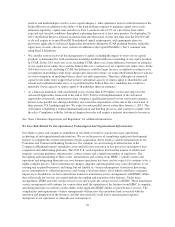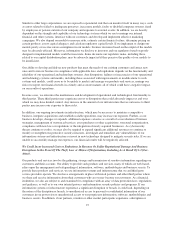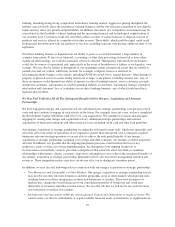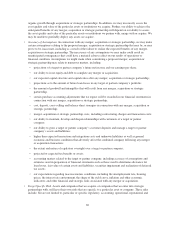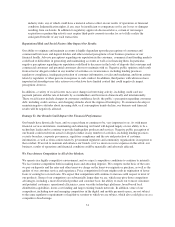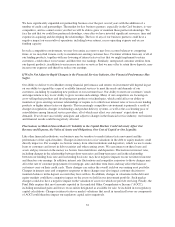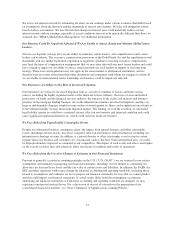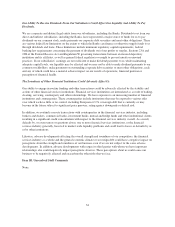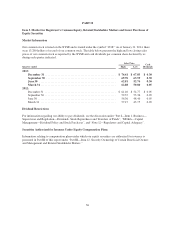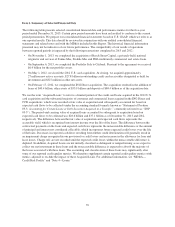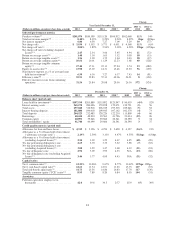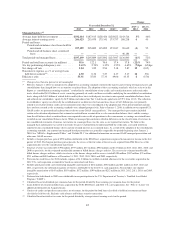Capital One 2013 Annual Report Download - page 52
Download and view the complete annual report
Please find page 52 of the 2013 Capital One annual report below. You can navigate through the pages in the report by either clicking on the pages listed below, or by using the keyword search tool below to find specific information within the annual report.We have significantly expanded our partnership business over the past several years with the additions of a
number of credit card partnerships. The market for key business partners, especially in the Card business, is very
competitive, and we cannot assure you that we will be able to grow or maintain these partner relationships. We
face the risk that we could lose partner relationships, even after we have invested significant resources, time and
expense in acquiring and developing the relationships. The loss of any of our business partners could have a
negative impact on our results of operations, including lower returns, excess operating expense and excess
funding capacity.
In such a competitive environment, we may lose entire accounts or may lose account balances to competing
firms, or we may find it more costly to maintain our existing customer base. Customer attrition from any or all of
our lending products, together with any lowering of interest rates or fees that we might implement to retain
customers, could reduce our revenues and therefore our earnings. Similarly, unexpected customer attrition from
our deposit products, in addition to an increase in rates or services that we may offer to retain those deposits, may
increase our expenses and therefore reduce our earnings.
If We Do Not Adjust to Rapid Changes in the Financial Services Industry, Our Financial Performance May
Suffer.
Our ability to deliver to stockholders strong financial performance and returns on investment will depend in part
on our ability to expand the scope of available financial services to meet the needs and demands of our
customers, including by marketing new products to our customer base. Our ability to meet our customers’ needs
and expectations is key to our ability to grow revenue and earnings. Many of our competitors are focusing on
cross-selling their products and developing new products or technologies, which could affect our ability to
maintain or grow existing customer relationships or require us to offer lower interest rates or fees on our lending
products or higher interest rates on deposits. This increasingly competitive environment is primarily a result of
changes in regulation, changes in technology and product delivery systems, as well as the accelerating pace of
consolidation among financial service providers, all of which may affect our customers’ expectations and
demands. If we do not successfully anticipate and adjust to changes in the financial service industry, our business
and financial results could be negatively affected.
Fluctuations in Market Interest Rates Or Volatility in the Capital Markets Could Adversely Affect Our
Revenue and Expense, the Value of Assets and Obligations, Our Cost of Capital or Our Liquidity.
Like other financial institutions, our business may be sensitive to market interest rate movement and the
performance of the capital markets. Changes in interest rates or in valuations in the debt or equity markets could
directly impact us. For example, we borrow money from other institutions and depositors, which we use to make
loans to customers and invest in debt securities and other earning assets. We earn interest on these loans and
assets and pay interest on the money we borrow from institutions and depositors. Fluctuations in interest rates,
including changes in the relationship between short-term rates and long-term rates and in the relationship
between our funding basis rate and our lending basis rate, may have negative impacts on our net interest income
and therefore our earnings. In addition, interest rate fluctuations and competitor responses to those changes may
affect the rate of customer prepayments for mortgage, auto and other term loans and may affect the balances
customers carry on their credit cards. These changes can reduce the overall yield on our earning asset portfolio.
Changes in interest rates and competitor responses to these changes may also impact customer decisions to
maintain balances in the deposit accounts they have with us. In addition, changes in valuations in the debt and
equity markets could have a negative impact on the assets we hold in our investment portfolio. Such market
changes could also have a negative impact on the valuation of assets for which we provide servicing. Finally, the
Final Rule requires that most amounts reported in Accumulated Other Comprehensive Income (“AOCI”),
including unrealized gains and losses on securities designated as available for sale,be included in our regulatory
capital calculations. Changes in interest rates or market valuations that result in unrealized losses on components
of AOCI could therefore impact our regulatory capital ratios negatively.
32



